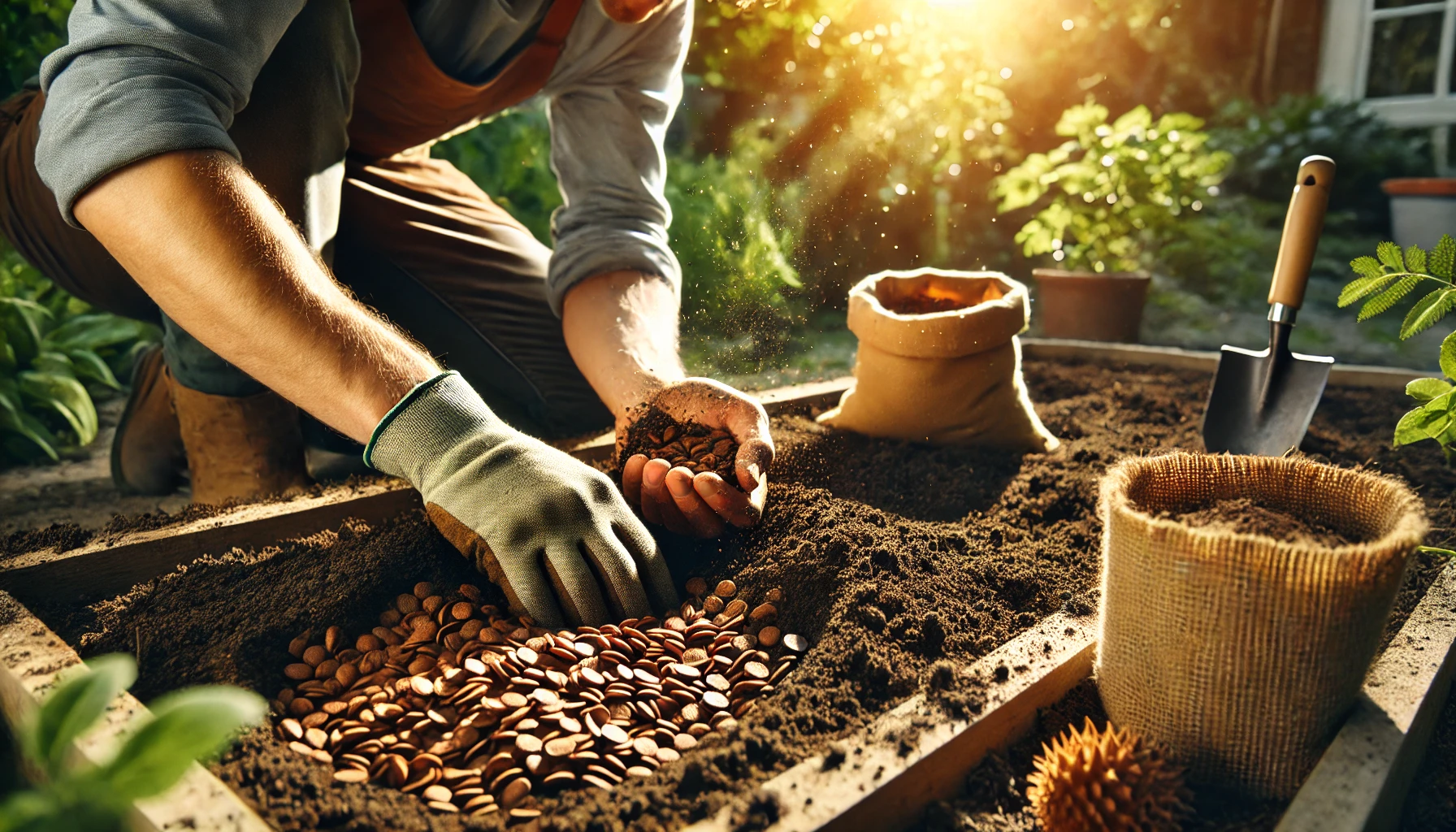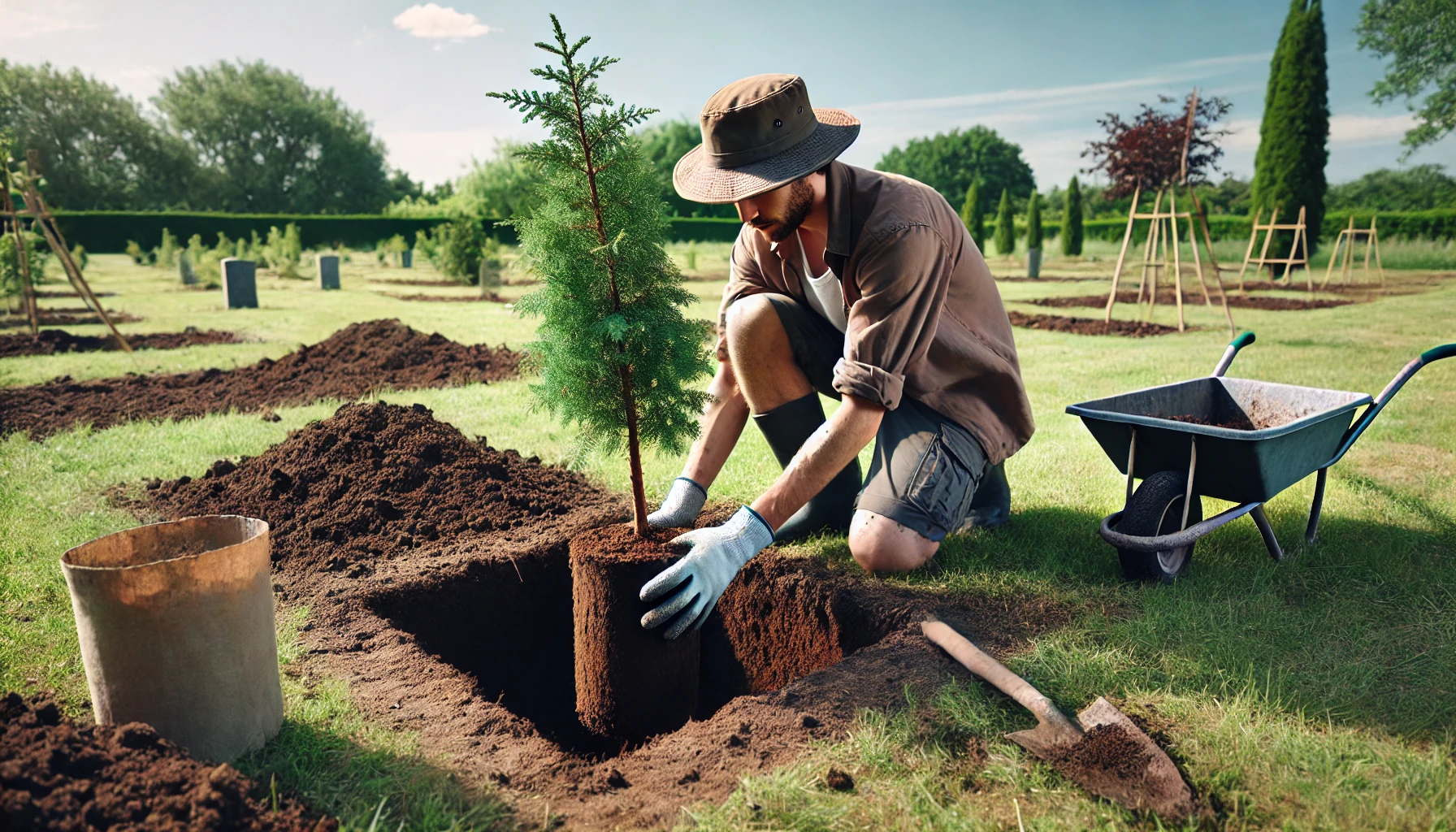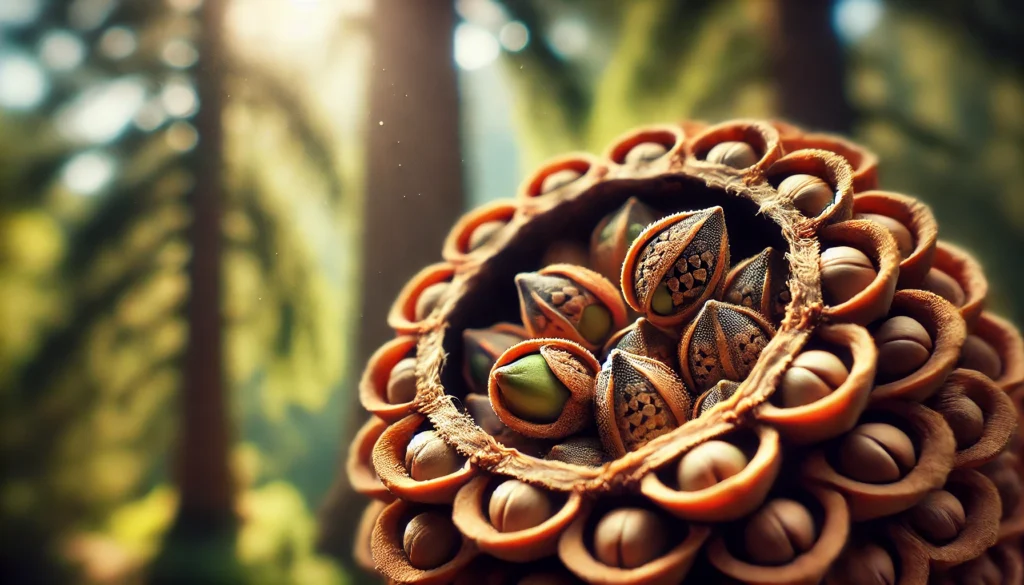
How to Grow Sequoia Trees from Sequoia Seeds: A Step-by-Step Guide for Successful Planting
Have you ever dreamed of growing a giant Sequoia tree from scratch? 
Growing Sequoia trees from seeds may seem like a daunting task, especially for beginners. The process requires patience, the right techniques, and a little bit of care. But don’t worry—this guide is designed to walk you through every step, ensuring you have all the knowledge needed to succeed. From preparing the seeds to caring for your young tree, we’ll cover everything you need to know to turn your dream into a reality.
Ready to watch your Sequoia seeds grow into incredible trees? Keep reading to discover the essential tips and tricks to make it happen!
Table of Contents
ToggleUnderstanding Sequoia Seeds and Their Potential 
Sequoia trees, with their towering heights and impressive longevity, are a symbol of nature’s grandeur. If you’re considering growing these majestic giants from seeds, it’s essential to understand their unique characteristics and how to unlock their potential. Let’s dive into what makes Sequoia seeds special and how you can harness that potential to successfully grow your own Sequoia tree!
1. What Are Sequoia Seeds?
Sequoia seeds come from the cones of Sequoia trees, mainly the Giant Sequoia (Sequoiadendron giganteum) and the Coast Redwood (Sequoia sempervirens). These seeds are small, typically only a few millimeters in length, but inside each one is the blueprint for a tree that can grow to be over 300 feet tall!
While tiny, these seeds hold immense potential to grow into some of the largest and oldest trees on Earth. But before you plant them, it’s important to note that Sequoia seeds have a natural dormancy period, meaning they need some help to break through that initial seed shell and start growing
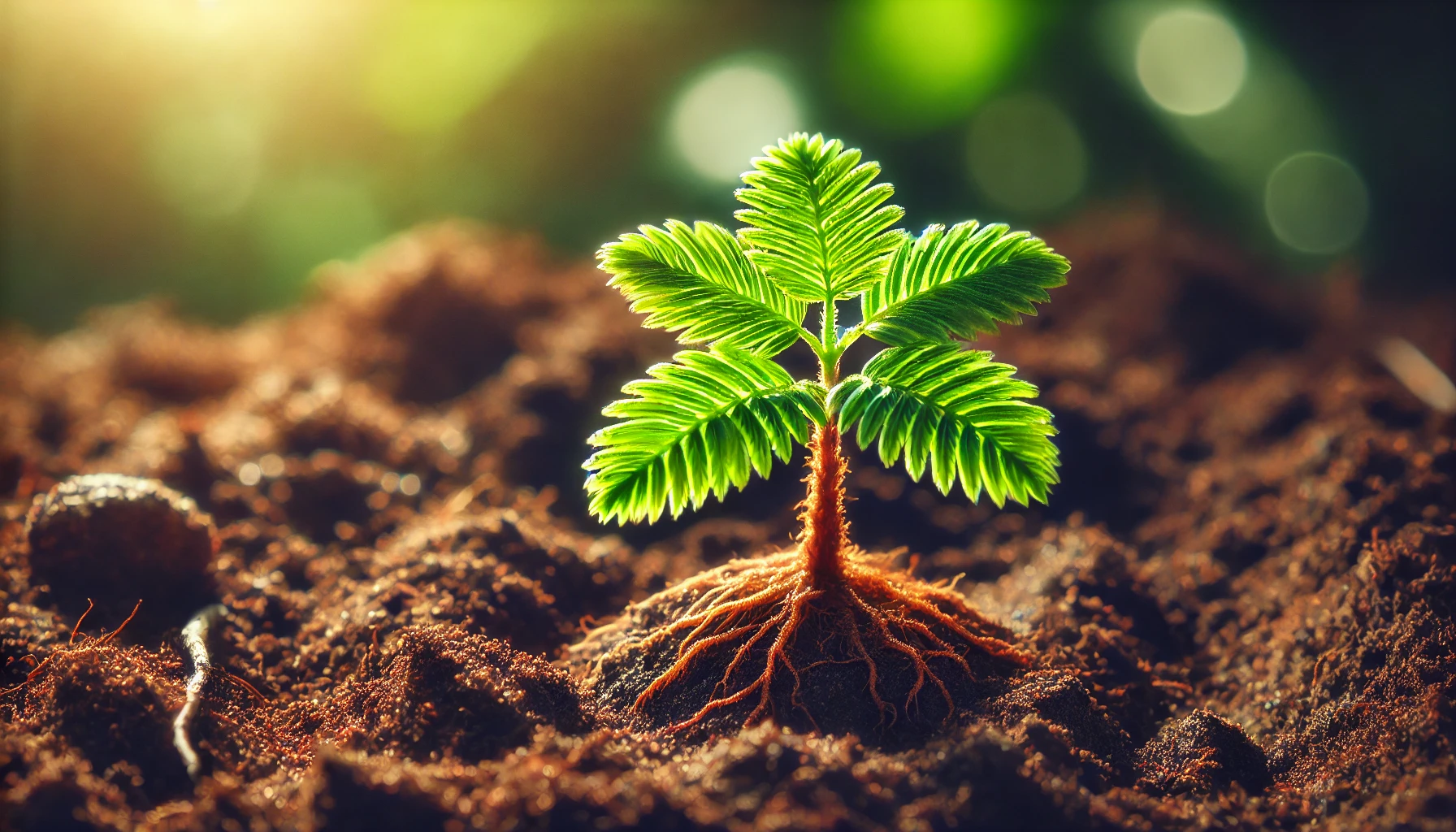
2. Why Are Sequoia Seeds Special? 
Sequoia seeds are remarkable for a few reasons:
- Longevity: Sequoias are among the oldest living organisms, with some trees living for over 3,000 years.
- Size: These trees can reach incredible heights, and the seeds carry the potential for that vast growth.
- Resilience: Sequoias are adapted to withstand harsh conditions, including drought and fire, making them a hardy choice for your garden.
However, growing these giants from seed isn’t without its challenges. Sequoia seeds need specific conditions to germinate and thrive, but don’t worry—we’ll guide you through the process in the next sections.
3. What You Need to Know Before Planting Sequoia Seeds 
- Cold Stratification: Sequoia seeds require a period of cold dormancy (called stratification) before they will germinate. This mimics the natural winter conditions that they would experience in the wild.
- Soil Requirements: While Sequoias are adaptable, they prefer well-draining, slightly acidic soil. They’re not picky, but ensuring the right soil mix can help them thrive early on.
- Light: Sequoia seeds need light to germinate, so plant them on the surface of your soil without covering them completely.
With the right preparation, Sequoia seeds have the potential to grow into an extraordinary tree that will stand as a testament to nature’s power for generations.
Stay tuned for our step-by-step guide on how to successfully plant and care for your Sequoia seeds in the following sections!
Preparing Sequoia Seeds for Planting 
Growing Sequoia trees from seeds is a rewarding process, but it requires some specific steps to ensure successful germination. Here’s a step-by-step guide to preparing your Sequoia seeds for planting so you can set your trees up for success!
1. Collecting the Seeds 
First, if you’re harvesting your own Sequoia seeds, make sure to gather them when they’re ripe. You’ll know they’re ready when the cones have turned brown and begun to open. Gently shake the cones to release the seeds, and then let them dry completely.
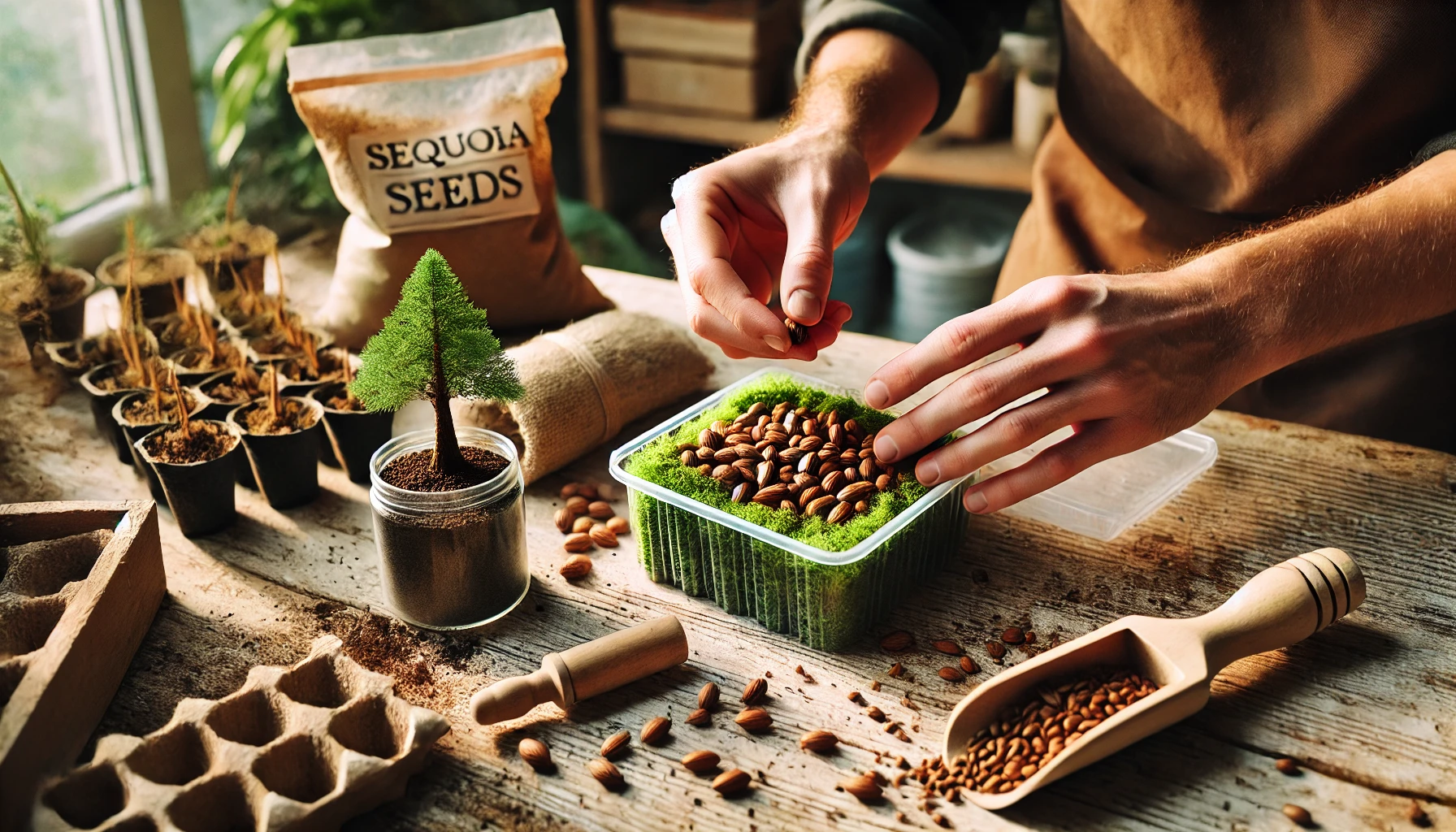
2. Stratification: Breaking Dormancy 
Sequoia seeds have a natural dormancy period, meaning they need to undergo stratification (a cold treatment) to germinate successfully. This mimics the cold winters of their native habitat.
- How to Stratify Sequoia Seeds:
- Place your seeds in a sealed plastic bag or container with some moist sphagnum moss or sand.
- Store the bag in the refrigerator for about 30 to 60 days. Make sure the moss or sand remains moist, but not soaking wet.
- Check the seeds occasionally to ensure they are not drying out or molding.
3. Preparing the Soil and Containers 
While your seeds are going through the cold stratification process, prepare the planting area or containers:
- Soil: Use well-draining, slightly acidic soil. A mix of peat, perlite, and sand works well for Sequoia seedlings.
- Containers: If planting indoors, small pots or seed trays will suffice. Ensure the containers have drainage holes to avoid waterlogging, which can harm the seeds.
4. Pre-Planting Seed Treatment 
Before planting, gently rub the seeds between your fingers to remove any excess moisture and help them breathe. This step can improve germination rates, especially after stratification.
5. When to Plant 
Once your seeds have completed the cold stratification process, you can plant them. This typically happens in early spring when temperatures begin to rise. Make sure the soil temperature is around 65–75°F (18–24°C) for optimal germination.
6. Planting the Seeds 
- Surface Planting: Sequoia seeds need light to germinate, so don’t bury them too deeply. Simply press them into the surface of the soil, ensuring they’re in good contact with it.
- Spacing: If planting multiple seeds, space them about 3-4 inches apart to give them room to grow.
By following these steps, you’ll be well on your way to growing healthy Sequoia trees! 
Planting Sequoia Seeds – The Right Technique 
Planting Sequoia seeds can seem like a daunting task, but with the right technique, you’ll be well on your way to growing these magnificent trees! 
1. Prepare the Seeds (Stratification Process) 
Sequoia seeds need a little nudge from nature to germinate. They require a process called stratification, which mimics the cold period they would naturally experience in the wild.
How to Stratify Your Seeds:
- Step 1: Place your Sequoia seeds in a small container or a ziplock bag.
- Step 2: Add a bit of damp sand or peat moss to the bag to keep the seeds moist but not soaking.
- Step 3: Seal the bag and place it in the fridge for about 4 to 6 weeks. This cold treatment will signal to the seeds that it’s time to start sprouting
.
2. Choose the Right Planting Time 
Timing is everything! The best time to plant Sequoia seeds is in early spring, after the frost has passed. This gives your seeds the warm soil they need to thrive. If you’re in a colder climate, consider starting your seeds indoors before transplanting them outside once the weather is suitable.
3. Prepare the Soil for Planting 
Sequoias love well-draining, loamy soil. Here’s how to prepare the perfect bed for them:
- Step 1: Choose a spot that gets plenty of sunlight (at least 6 hours a day).
- Step 2: Loosen the soil with a garden fork to ensure good root penetration. If your soil is too clay-heavy, mix in organic compost to improve drainage.
- Step 3: Make sure the soil is moist but not waterlogged
.
4. Planting the Seeds 
Now comes the fun part—planting your Sequoia seeds!
- Step 1: Create shallow holes or rows in the soil. The holes should only be about 1/8 inch (3mm) deep. Sequoia seeds are tiny, so planting too deep will prevent them from sprouting.
- Step 2: Gently scatter the seeds in the holes, spacing them about 6 inches apart. You can plant multiple seeds per hole to increase the chances of germination, but remember to thin them out once they sprout.
5. Watering and Caring for the Seeds 
Keep the soil consistently moist, but not soggy. Overwatering can lead to rot, so it’s essential to find the right balance.
- Tip: Mist the surface lightly every day until the seeds begin to sprout. After that, water gently to avoid disturbing the tiny roots.
6. Patience is Key 
Sequoia seeds can take anywhere from 2 to 6 weeks to germinate, so be patient! During this time, protect your seeds from heavy winds, pests, and animals that might disturb them.
7. Transplanting and Growing Strong 
Once your seedlings have grown strong enough and the weather is right, you can transplant them to their permanent location. Keep in mind that Sequoia trees grow rapidly once established, so space them out to allow room for their majestic growth.
Final Thoughts 
Planting Sequoia seeds is a rewarding process that requires a little patience and care. By following these simple steps, you’ll increase your chances of success and watch your Sequoia trees grow from tiny seeds to towering giants 
Caring for Sequoia Seedlings 
Once your Sequoia seeds have germinated and grown into small seedlings, the next step is providing the proper care to help them thrive. Growing these majestic trees from seeds requires patience and attention, but with the right guidance, your Sequoia seedlings can grow strong and healthy. Here’s how to take care of them during their early stages:
1. Provide Plenty of Light 
Sequoia seedlings need a lot of light to grow well. Place them in a location where they can receive several hours of indirect sunlight each day. A south-facing window is perfect! If you’re growing them indoors, you may also consider using a grow light to ensure they get enough light during the darker months.
2. Watering: Keep the Soil Moist, Not Waterlogged 
Water your seedlings regularly, but don’t let them sit in water. Sequoias like moist, well-drained soil. Overwatering can cause root rot, so ensure the soil drains properly. Aim for keeping the soil damp, but not soggy. Check the soil frequently, especially during hot weather, and water when the top layer feels dry.
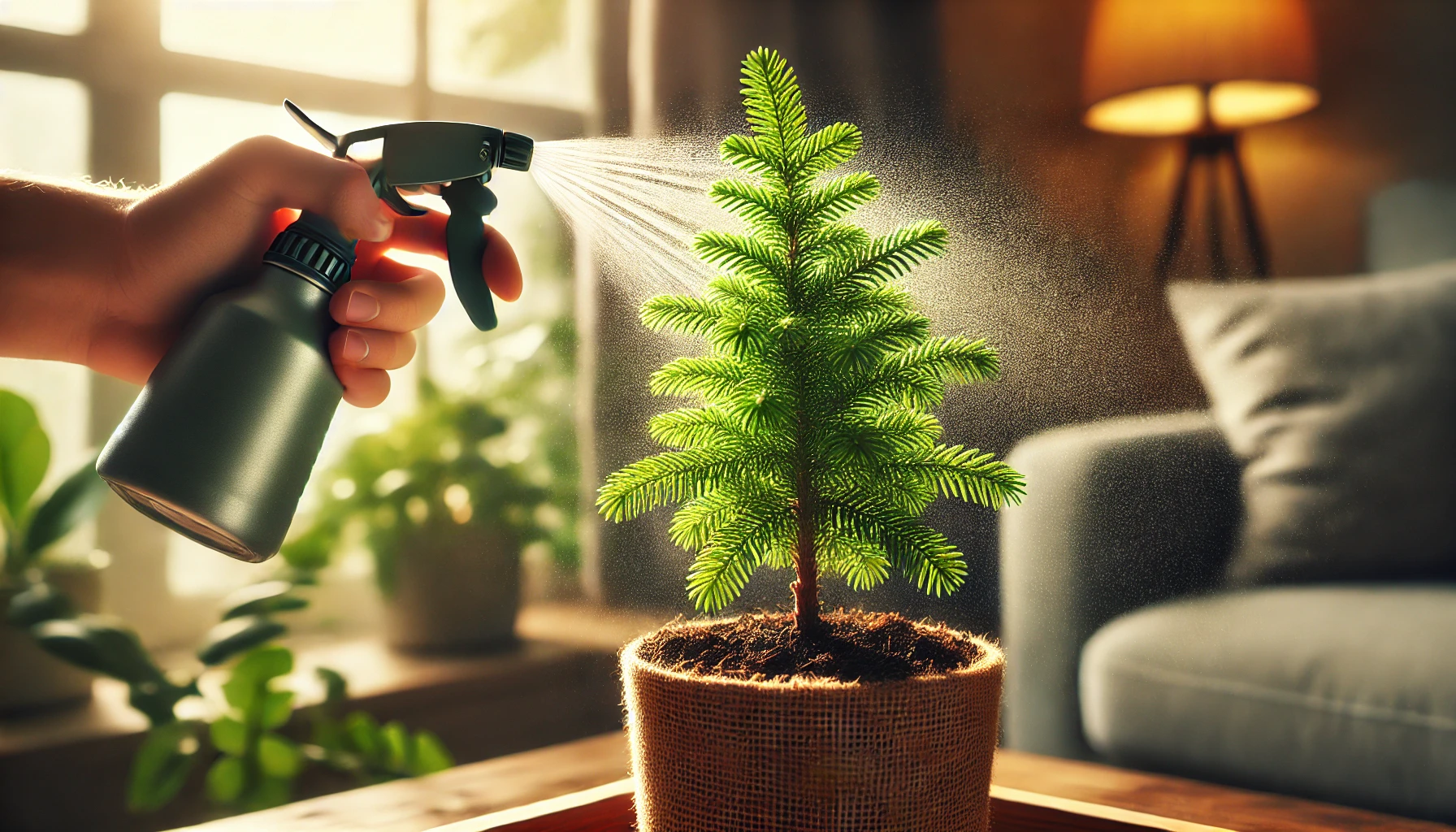
3. Use a Humidity Tray or Dome for Humidity 
Sequoia seedlings thrive in humid conditions. To mimic the high humidity of their native habitat, you can place your seedlings in a humidity dome or set up a humidity tray. A simple DIY solution is to put your seedlings in a shallow tray filled with pebbles and water—this will raise the moisture levels around the plants.
4. Ensure Proper Temperature 
Sequoia seedlings prefer cool temperatures, ideally between 50°F and 75°F (10°C to 24°C). Avoid placing them in locations that are too hot or cold, as extreme temperatures can stress the young plants. If you’re growing them indoors, make sure they’re in a draft-free area.
5. Fertilize Lightly 
Once your Sequoia seedlings are a few months old, you can start fertilizing them. Use a balanced, slow-release fertilizer. However, don’t overdo it—too much fertilizer can burn the roots. Apply fertilizer every 4 to 6 weeks during the growing season (spring and summer).
6. Thin Them Out for Stronger Growth 
If your Sequoia seedlings are crowded, thin them out. This gives the remaining seedlings more space to grow and ensures they aren’t competing for nutrients and light. Gently remove the weaker seedlings to allow the stronger ones to thrive.
7. Transplant When Ready 
As your Sequoia seedlings grow, they will eventually need more space. Once they’re about 6 inches tall and have a good root system, it’s time to transplant them into larger pots or directly into the ground. Be sure to choose a location with well-drained soil and plenty of space for your Sequoias to grow tall and strong.
By following these simple steps, you’ll set your Sequoia seedlings up for success as they grow into the towering trees they’re destined to become. Patience is key, but with the right care, you’ll soon be watching your little seedlings turn into majestic giants!
Transplanting Sequoia Trees Outdoors 
Once your Sequoia seedlings have grown strong and healthy in their indoor or nursery environment, it’s time to give them a new home outdoors. Transplanting Sequoia trees can be an exciting step in their growth journey, but it requires careful planning and attention to detail. Here’s how to ensure your Sequoias thrive once they’re planted outside.
1. Choose the Right Location 
Sequoias need a lot of space to grow, so selecting the right spot is crucial. These majestic trees can grow incredibly tall, so pick a location with plenty of room for them to stretch their branches. Ideally, the area should have:
- Full sunlight: Sequoias love the sun and need at least 6-8 hours of direct sunlight a day.
- Well-drained soil: Make sure the soil isn’t waterlogged. Sequoias don’t like soggy roots.
- Protection from strong winds: While Sequoias are tough, young trees can be vulnerable to wind damage. Consider planting near a natural windbreak or erecting a temporary one.
2. Prepare the Soil and Planting Hole 
Before you transplant, you’ll want to prepare the ground. Follow these steps:
- Dig a wide, deep hole: The hole should be about twice as wide as the seedling’s root ball and deep enough so the tree’s root system can spread freely.
- Amend the soil: Mix in organic compost or well-rotted manure to improve soil structure and fertility. Sequoias thrive in rich, slightly acidic soil.
- Water well: Before planting, give the hole a thorough watering. This will help the roots establish more easily.
3. Transplanting Your Seedling 
Now that your location is ready, it’s time to transplant your Sequoia. Follow these simple steps:
- Gently remove the seedling from its container or pot. Be careful not to damage the delicate roots.
- Place the seedling into the hole, ensuring the root ball is level with the surrounding ground. Avoid planting too deep or too shallow, as this can affect the tree’s growth.
- Fill the hole with soil, pressing lightly as you go to eliminate air pockets around the roots.
- Water thoroughly after planting. Sequoias need plenty of water to settle in, especially during their first few weeks in the ground.
4. Mulch for Moisture Retention 
Mulching around the base of your Sequoia tree can work wonders in the first few months. A 2-3 inch layer of mulch helps retain moisture, keep the soil temperature steady, and prevent weed growth. Just be sure to keep mulch away from the tree trunk to avoid rot.
5. Ongoing Care and Maintenance 
After transplanting, your Sequoia tree will need some extra attention to thrive:
- Watering: Keep the soil consistently moist, especially during the warmer months. A young Sequoia may need watering every 2-3 days in dry periods.
- Fertilizing: Once your tree is established, fertilize it once or twice a year with a balanced, slow-release fertilizer to encourage growth.
- Pruning: Only prune dead or damaged branches in the early years. Sequoias are naturally symmetrical and generally don’t require heavy pruning.
With a little patience, your Sequoia will soon be settling into its new outdoor home and growing toward the sky.
Remember, the key to success when transplanting Sequoia trees is proper timing, a suitable location, and consistent care. Follow these tips, and you’ll be well on your way to growing a magnificent Sequoia tree!
Long-Term Care for Your Growing Sequoia Tree 
Once you’ve planted your Sequoia tree from seeds, the real work begins! Caring for your tree as it grows is essential to ensure it thrives for years to come. These magnificent giants need the right environment, proper maintenance, and a bit of patience. Let’s break down the key areas for long-term care.
1. Choose the Right Location 
Sequoias love the outdoors and need plenty of space to grow. Plant them in a location that receives full sunlight for most of the day. 
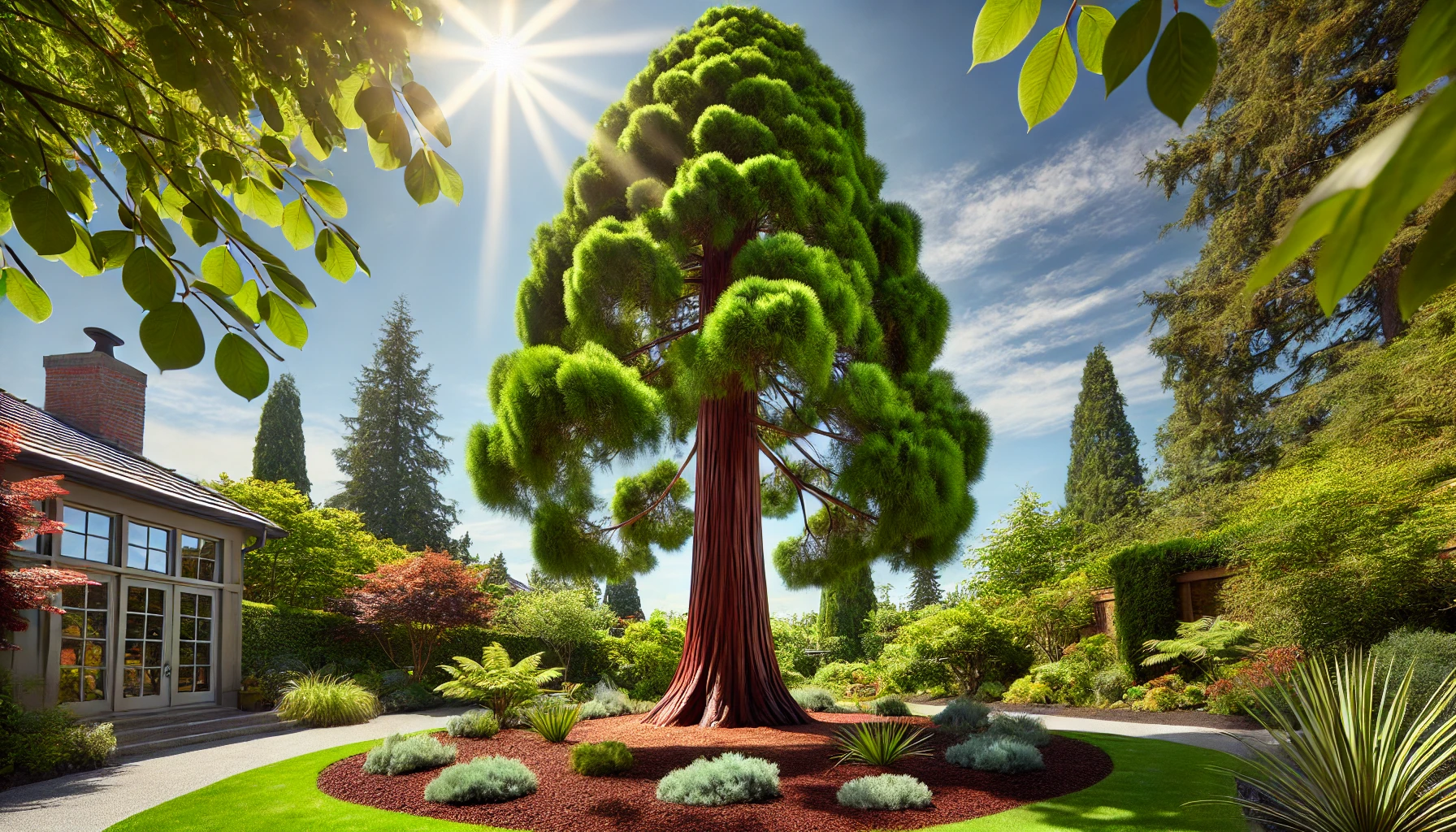
2. Watering Wisely 
While Sequoias are drought-tolerant once established, young trees need consistent watering. Water them deeply, especially during dry spells. Aim to keep the soil moist but not soaked, as this can lead to root rot. During hot summer months, check the soil moisture regularly. A good rule of thumb is to water the tree when the top 2 inches of soil feel dry.
3. Mulch for Moisture Retention 
Adding a layer of mulch around your tree helps keep the soil cool and retains moisture. Mulch also reduces competition from weeds that may otherwise rob the tree of essential nutrients. Use organic mulch like wood chips or pine needles, and keep the mulch layer about 2 to 3 inches thick. Be careful not to pile it against the trunk to prevent rot.
4. Pruning for Shape and Health 
Sequoia trees don’t require much pruning, but occasional trimming can help with their overall health and shape. Remove dead or damaged branches to improve airflow and prevent disease. Be sure to make clean cuts to avoid injuring the tree. When pruning, focus on the lower branches as the tree matures, allowing the trunk to grow taller and straighter.
5. Fertilizing for Growth 
While Sequoia trees can survive in less fertile soil, they will benefit from a boost of nutrients. Use a slow-release fertilizer in the spring to promote healthy growth. Make sure the fertilizer is high in nitrogen, which is vital for leafy growth. Avoid over-fertilizing, as this can lead to weak, spindly growth and even damage the tree.
6. Protecting from Pests and Diseases 
Keep an eye out for common pests like aphids, mites, or scale insects. Sequoias are generally pest-resistant, but young trees are more vulnerable. If you notice any pests, treat your tree with an organic pesticide or use natural predators like ladybugs. Fungal diseases, especially in damp conditions, can also pose a threat. Ensure your tree has good air circulation to reduce the likelihood of infection.
7. Patience and Time 
Sequoias are slow growers, especially in the first few years. Don’t be discouraged if you don’t see rapid growth. With time, they can grow up to 2-3 feet per year, reaching enormous heights. As they mature, their growth rate will accelerate, and your Sequoia will eventually become the towering tree it’s meant to be!
8. Seasonal Care Tips 

Spring & Summer: Focus on watering and pruning. Make sure your Sequoia gets plenty of sunlight and protection from harsh winds.
Fall & Winter: Reduce watering during the cooler months. You can also add more mulch before the first frost to help protect the roots from cold damage.
9. Tree Supports for Young Sequoias 
As your Sequoia grows, it might need support in the form of stakes, especially during strong winds. This is particularly important for young trees still establishing their root systems. Ensure the stake is gentle on the tree and not tied too tightly to avoid damage.
With these simple tips, you’ll be well on your way to growing a healthy, happy Sequoia tree that will stand tall for generations to come! Keep nurturing your tree, and in time, you’ll have a magnificent specimen to admire 
Conclusion
Growing Sequoia trees from Sequoia seeds is an incredibly rewarding journey that requires patience, care, and the right techniques. From the moment you plant the seeds to the day your Sequoia tree towers over your garden, the process offers a sense of accomplishment and connection to nature.
By following the step-by-step guide outlined here, you now have the knowledge to successfully plant and nurture your Sequoia trees. Whether you’re a beginner gardener or an experienced grower, the steps to grow these majestic trees are simple to follow and lead to long-term rewards. Remember, the key is to be patient and provide your trees with the proper care they need to thrive—after all, these trees can live for centuries!

So, take the first step today, and start your Sequoia tree-growing adventure. With the right environment, attention, and a little time, you’ll soon have your very own Sequoia tree standing tall and proud. 
Frequently Asked Questions(FAQ)
How long does it take for Sequoia seeds to germinate?
Sequoia seeds typically take 1 to 3 weeks to germinate, depending on the temperature and moisture levels. It’s important to keep the soil consistently moist and ensure the seeds are kept in a warm environment to speed up the process.
Can I grow Sequoia trees indoors?
Yes, you can start Sequoia seeds indoors, especially during the cold months. However, Sequoia trees eventually need to be transplanted outdoors to their permanent location once they are strong enough to handle full sunlight and outdoor conditions.
What is seed stratification, and why is it important for Sequoia seeds?
Seed stratification involves simulating a cold winter environment to help Sequoia seeds break dormancy. You can stratify the seeds by placing them in the refrigerator for 4–6 weeks before planting. This process increases the chances of successful germination.
How deep should I plant Sequoia seeds?
Sequoia seeds should be planted about 1/8 to 1/4 inch deep in well-draining soil. Planting too deep can hinder germination, so it’s best to lightly cover the seeds with soil and keep them in a warm, moist environment.
When is the best time to transplant Sequoia seedlings outdoors?
The best time to transplant Sequoia seedlings outdoors is during the spring or fall, when the weather is mild. Before transplanting, ensure that the seedlings have grown strong enough and have been hardened off (gradually exposed to outdoor conditions).
What type of soil do Sequoia seeds need to grow?
Sequoia seeds thrive in well-draining, fertile soil with good organic content. The soil should retain some moisture but not stay soggy. You can use a mix of potting soil and perlite or sand to improve drainage.
How often should I water Sequoia seeds and seedlings?
Sequoia seeds and seedlings need consistent moisture but should not be overwatered. Keep the soil damp but not waterlogged. Once seedlings are established, water them deeply once or twice a week, depending on weather conditions.
How big do Sequoia trees get, and how fast do they grow?
Sequoia trees can grow 3 to 5 feet per year under the right conditions. Eventually, they can reach over 200 feet tall. While they grow quickly in their early years, they require long-term care to reach their full potential.






